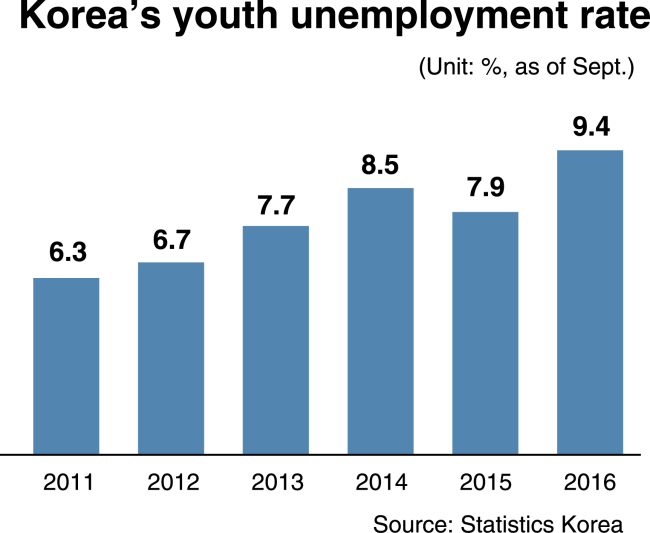The government-proposed budget for next year has set aside 17.5 trillion won ($15.4 billion), up 10.7 percent from this year, to finance programs designed to create jobs.
In her parliamentary speech Monday, President Park Geun-hye described the 2017 spending plan as a job-creating one.
Since its installment in February 2013, Park’s administration has put the focus of labor market policy on helping more people into employment. Over the past few years, Korea has seen its overall employment rate edge up due mainly to a growing number of older people rejoining the workforce, mostly on irregular and temporary terms.
But youth unemployment has continued to worsen, with critics saying the government’s employment policy has done little to create more decent jobs that well-educated young jobseekers want.
The unemployment rate of people aged 15-29 has remained at around 10 percent in the first nine months of this year, peaking at a record high of 12.5 percent in February.
According to recent figures from Statistics Korea, the youth jobless rate reached 9.4 percent in September, a 1.5 percentage point rise from a year earlier and the highest number for the month since the statistics office began compiling related data in 1999. The country’s overall unemployment rate stood at 3.6 percent last month.
A survey released on the same day as Park gave her parliamentary speech showed more young people remained gloomy on the chances of landing jobs.
In the poll of 3,461 college students, conducted by the Federation of Korean Industries, more than half said job market conditions have worsened from a year earlier for fresh graduates. Only 2.6 percent saw an improvement.
In a reflection of the severe job mismatch in the country, 1 in 3 people unemployed in the third quarter of the year was a university graduate, according to the data from the statistics agency. The number of jobless people with a bachelor’s degree amounted to 315,000 during the cited period, surpassing the 300,000 mark for the first time.
Experts attribute the rising youth unemployment to a combination of academic inflation and a protracted economic downturn.
The proportion of Korean high school graduates entering university rose from 33.2 percent in 1990 to 70.9 percent in 2014, the highest rate among the 34 members of the Organization for Economic Cooperation and Development.
Higher educational backgrounds have raised job expectations.
In the FKI survey, more than half of respondents wished to work for either a large private company or a public corporation. Only 5.3 percent said they planned to look for a job at small and medium-sized enterprises, which hire nearly 90 percent of waged workers across the country.
With uncertainties growing over business conditions at home and abroad, however, the country’s major companies have remained reluctant to increase employment.
According to a study by a research institute affiliated with the Federation of Korean Trade Unions, the number of workers employed by Korea’s top 20 and 100 companies increased by 3.4 percent and 7.3 percent, respectively, during the period between 2012 and 2015 while the total employment rose by 13.4 percent over the cited years.
In particular, 12 large companies reduced jobs while seeing their assets growing.
“Large profitable companies have paid little attention to sharing profits with society through more employment,” said Hwang Seon-ja, a researcher at the FKTU institute.
She called for the government to be more active in pushing major companies to offer more job opportunities.
Experts note government policymakers should also accelerate deregulation especially in the services sector to encourage companies to increase investment and hire more workers.
What is equally important is to narrow the wage gap between large corporations and smaller companies.
According to data from the Small and Medium Business Administration, the average monthly wage paid by corporations with 300 or more employees in the first five months of this year amounted to 5.14 million won, compared to 3.17 million won for firms with five to 299 workers.
The average pay of SMEs fell from 65.8 percent of the average large company salary in 2003 to 62 percent in 2015 and 61.6 percent in the January-May period of the year.
Apparently acknowledging the discrepancy between their expectations and the job market reality, about 15 percent of respondents in the FKI survey said they would probably end up landing a job at a small company.
This proportion will increase if the wage gap between large and smaller firms is narrowed further, experts say.
They say large corporations need to refrain from passing cost-cutting burdens to their subcontractors and the government should strengthen support for SMEs that increase wages and other benefits for their employees.
Rep. Hong Young-pyo, who heads the parliamentary labor committee, asked trade unions at large companies to make concessions to help ease the polarization of the job market.
He said the labor market should become more flexible in the face of technological advances accompanied by a gradual shift from the traditional model of employment to more flexible forms of working.
By Kim Kyung-ho (
khkim@heraldcorp.com)








![[Today’s K-pop] Blackpink’s Jennie, Lisa invited to Coachella as solo acts](http://res.heraldm.com/phpwas/restmb_idxmake.php?idx=644&simg=/content/image/2024/11/21/20241121050099_0.jpg)